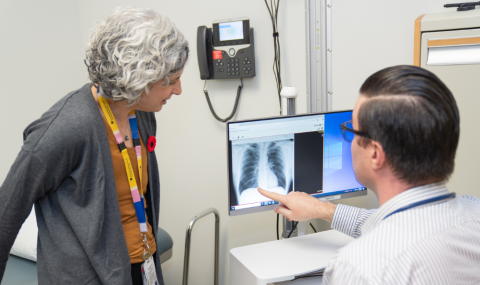Voluntary movement requires the transmission of a message from the motor strip of the cerebral cortex (upper motor neuron) to the appropriate muscle on the opposite side of the body. Thus, injury to the cerebral cortex causes decreased muscle function contralaterally (on the side of the body opposite to the brain injury). While the ability to tell the muscle to move is a function of the cerebral cortex, the ability to make the movement smooth and coordinated requires the cerebellum. Shaky or uncoordinated movements may be the result of cerebellar dysfunction. The cerebellum controls smoothness of movement on the same side (the message to move the left leg comes from the right cerebral cortex, but is coordinated and made smooth by the left hemisphere of the cerebellum).
- If motor function is intact, muscles can be moved to command. Symmetrical movement and strength is one of the most important assessment findings. Reduced motor function can occur as a result of injury to the cerebral cortex, motor pathway, peripheral nerve or muscle. While it takes a certain level of function to move a muscle to command, increased innervation and muscle strength is required to overcome gravity. Even greater strength is required to overcome resistance by an examiner.
- Assessment of motor function can be graded in patients able to obey commands as follows (right compared to left):
5 = normal strength (normal strength, able to maintain the muscle contraction against examiner resistance)
4 = mild weakness ( weakly or briefly able to overcome examiner resistance)
3 = able to support the limb against resistance but unable to overcome examiner resistance
2 = can move the limb, but unable to lift against gravity
1 = flicker but no movement
0 = no movement
- While an intensive evaluation can be performed for each muscle groups, a quick way to identify motor weakness is the assessment for limb drift.
Upper Extremity Strength
Conscious individual
Have the patient hold arms out horizontally, palms up, with eyes closed. If there is upper limb weakness, the affected side will "drift" or pronate within 30 seconds.Lower Extremity Strength
Conscious individual
With the patient lying in a supine position, bend the knees to 30 degrees. If there is weakness in the lower extremities, the affected leg will drift downward within 30 seconds.
- With patient in supine position, flex both knees and support under one of examiners arms. Allow one heel to rest on the bed. Extend the other leg at the knee and allow it to drop gently to the bed. Compare the speed of drop for both legs.
- Upper Extremity Strength
Unconscious individualLift both patient's arms together. While protecting the limbs from injury, release both arms together. A paralysed arm will fall more rapidly.
- Lower Extremity Strength
Unconscious individual
- Position patient supine. Flex the knees with both feet on the bed. Release the knees simultaneously. A paralysed leg will fall to an extended position and the hip will rotate externally. The normal leg will stay flexed for a few seconds and gradually assume the previous position.
What other observations can be made to assess motor function in an unconscious patient? - Observe the patient as they make spontaneous movements. Note the symmetry of movement. If the individual does not respond to command, but makes purposeful movements such as pulling at lines or tubes, the response is referred to as localizing. This is an appropriate response that requires functional motor pathways.
- If no spontaneous movement is noted, provide central pain stimulation. Central pain can be tested by rubbing the sternum, squeezing the the tissue in the axilla, squeezing the trapezius muscle at the angle of the neck and shoulder or by applying supraorbital pressure (avoid if facial fractures present). Interchange technique to avoid bruising or injury to tissues. If response is obtained to central pain, peripheral stimulation is not needed. Peripheral pain may produce a spinal reflex, and is therefore, not an effective test of upper motor neuron function.
- Withdrawal can be described by the presence of normal flexion in response to pain. Pulling away without flexing the wrist is one way to differentiate normal flexion from abnormal flexion. Rigid flexion is considered abnormal flexion. Rigid extension is referred to as abnormal extension. Absence of movement or tone is referred to as flacid paralysis.
What other assessments evaluate motor function? - In addition to the assessment of strength described above, muscles should be inspected and palpated. Inspect for asymmetrical movement or abnormal limb rotation. Palpatate the muscle for decreased (flacid) or increased (spasticity). Decreased tone may represent early upper motor neuron or peripheral nerve injury. Increased tone is associated with upper motor neuron injury.
-
Brenda Morgan, Clinical Educator
November 19, 1999 - Updated: January 15, 2019
References:
Bates, B. (1983). A Guide to Physical Examination. (3rd Edition). Philadelphia: Lippincott. pp 411.
Price, M., and DeVroom, H. (1985). A quick and easy guide to neurological assessment. Journal of Neuroscience Nursing. 17(5), pp 313-320.
Riggio, S., and Jagoda, A. (1999). The rapid neurolgic examination, Part 2: Movement, reflexes, sensation, balance. Journal of Critical Illness. 14(7), pp 368-372.
Snell, R. (1992). Clinical Neuroanatomy for Medical Student. Toronto: Little & Brown.
Waxman, S. (1996). Correlative Neuroanatomy (23rd Edition). Connecticut: Appleton and Lange. pp 205, 348.



